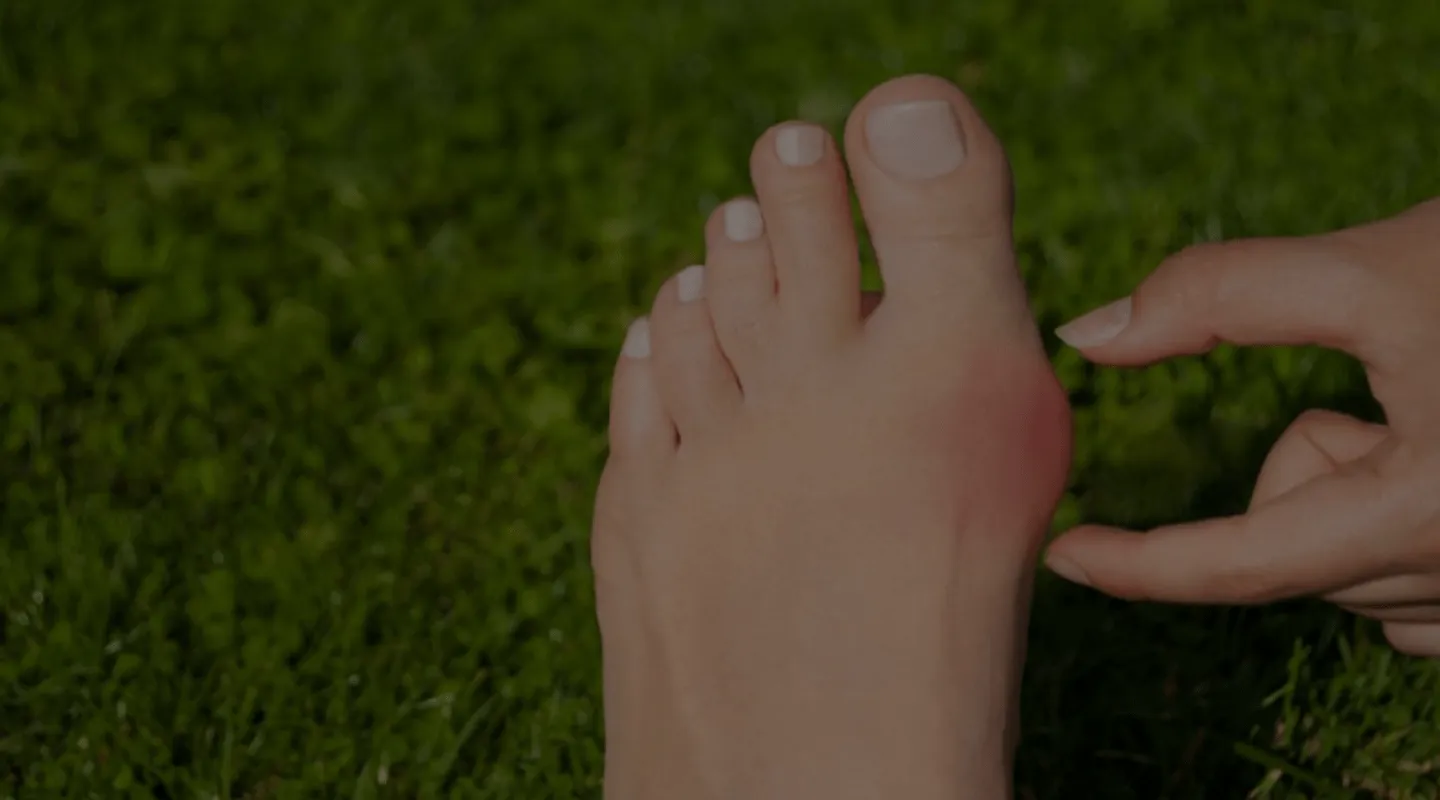
Hallux Valgus
Your Hallux Valgus surgery in Tunisia at an affordable price
Benefit from minimally invasive surgery performed by expert foot pathology orthopedists.
How does it work?
What is Hallux Valgus?
Hallux valgus is a deformity affecting the big toe, characterized by a “deformation” of the first metatarsal bone. It is therefore a skeletal and structural deformity. Hallux valgus affects women far more frequently than men and is the leading cause of surgical intervention for swollen feet. The cause of this condition has not yet been defined. Some claim that pointed shoes and heels play a significant role, but in reality, all surgeons end up operating on patients with bunions who, in their lives, have worn high-heeled shoes as well as patients who have preferred to wear “comfortable” hallux valgus shoes. It is therefore clear that the cause is not to be found in simple shoes, but that there is an important relationship with posture and any related defects.
Who is a candidate for hallux valgus surgery?
Hallux valgus surgery, also known as bunion surgery, is primarily for individuals suffering from persistent and severe pain at the base of the big toe due to progressive deformity. This intervention is particularly recommended for those whose symptoms do not improve with conservative treatments such as orthotics, shoe modifications, or anti-inflammatory medications. Ideal candidates for this surgery are often adults, although some adolescents with severe deformities may also benefit. The operation is usually considered when the pain significantly interferes with daily activities, mobility, and quality of life. In addition, individuals whose hallux valgus deformity leads to additional complications such as painful calluses, corns, or arthritis of the big toe may also be suitable candidates. It is essential that patients have realistic expectations regarding the results of surgery and are prepared to follow a post-operative rehabilitation program to ensure optimal recovery. The decision to undergo hallux valgus surgery should always be made in consultation with a specialized orthopedic surgeon who assesses the severity of the condition and discusses appropriate treatment options.
Why does hallux valgus mainly affect women?
Hallux valgus mainly affects the female sex. This condition affects 23% of women between the ages of 18 and 65, a percentage that increases with age: after 65, values exceed 35%. The big toe appears to be laterally deviated, sometimes turned outwards. A painful reactive bursitis (swelling) forms on the medial side of the base, which corresponds to the head of the first metatarsal. Over time, the deformity worsens. This results in an overload at the front of the foot which modifies the load on the metatarsal heads by deforming the second toe. The causes responsible for hallux valgus orthosis may be related to genetic factors. Other causes may also be: inflammatory diseases (such as rheumatoid arthritis), consequences due to fractures of the bones of the foot or ankle. It may also be a matter of bad habits that modify the biomechanics of the step: the use of bad shoes (with high heels or narrow soles) which can favor the early development of valgus of the big toe.
Hallux Valgus Price in Tunisia
The average price of a Hallux Valgus procedure is 2500 EUR for one foot and 3800 EUR for both for a 3-night stay. This all-inclusive price includes all expenses (orthopedic surgeon, anesthesiologist, operating room, hospitalization, nursing staff, dressings and post-operative check-ups), airport transfer costs, full board clinic and hotel. The price also includes surgical shoes and crutches if needed. Hallux Valgus rates in Tunisia remain much more competitive than those in European and American countries. Choosing Tunisia for your Hallux Valgus means saving money on your procedure while benefiting from the highest standards of hygiene, quality and professionalism.
Your health, our priority.
Request your free quote.
Before the Hallux Valgus intervention
It is essential to arrive on the day of the operation having followed all the pre-operative instructions given by the treating orthopedic surgeon and by the healthcare personnel in order to be prepared and to minimize the risk of complications. Fasting is mandatory from the day before. On the eve or the day before the hallux valgus operation, the medical file will be established by a doctor from the team and, if necessary, additional X-rays or other checks will be requested. The patient will also be reminded to bring their postoperative shoe and, if necessary, two crutches for proper support.
Hallux valgus: when to operate
Hallux valgus surgery remains the only true treatment for hallux valgus. Sometimes, a type of orthopedic prosthesis can be useful in cases where the symptomatology is only reserved for the metatarsals. On the other hand, it is not an effective remedy in cases of bursitis or pain in the lateral metatarsal area. Surgery then remains the only solution. There are various techniques that the surgeon can use. We speak of open surgery, minimally invasive/percutaneous or mixed techniques.
Open surgery
The “open sky” surgical technique remains the classic method for the treatment of hallux valgus. This method involves an incision allowing the articulation to be completely exposed so that the surgeon can intervene directly. This technique is defined as open because it allows direct visualization of the articulation or the bone segment in question. This has advantages and disadvantages. It allows for the possibility of clearly seeing the joint. Remarkable surgical precision is an asset for this technique. However, the limitation linked to the size of the surgical incision remains a point in disfavor of this type of intervention.
Minimally invasive or percutaneous surgery
Minimally invasive or percutaneous surgery is performed using small skin incisions, through which surgical instruments are introduced. These “mini-incisions” are very similar to those used by dentists. In the traditional minimally invasive technique, no means of synthesis (screws, threads or plates) is used to synthesize the osteotomies created. This is perhaps why the foot tends to remain swollen longer after the operation, because the osteotomies, without means of synthesis, need more time to heal. In addition, the non-use of synthetic means increases the importance of the role of the bandage, which becomes an integral part of the surgical procedure. Indeed, the dressing must be carefully carried out in the still sterile operating room, with a specific and fundamental trick. It should not be taken care of by the patient postoperatively and may, in some cases, require intermediate monitoring. In parallel, the advantages of this technique remain numerous: small incisions, short operating time, reduced bleeding etc. There are some disadvantages that do not affect the validity of the technique, but which the patient must know: prolonged swelling for a longer period compared to traditional techniques. This is sometimes also associated with prolonged peripheral pain, linked to a longer healing time of the osteotomy due to the lack of synthetic means.
Hallux valgus treatment
Sometimes, minimally invasive and percutaneous techniques cannot correct the defects involved in hallux valgus. The surgeon must be free to choose the technique best suited to the type of deformation present. Patients often have more articulated and complex deformities. In such cases, however, the possibility of minimally invasive surgery should not be completely excluded. In fact, we are talking about mixed techniques, which involve some corrections made with the percutaneous technique and others through small incisions. The difference between mixed techniques and traditional open techniques is that these attempt to minimize surgical incisions and the consequent exposure of the joint by performing mini-incisions and resorting, if possible, to percutaneous surgery.
Duration of hallux valgus surgery
The duration of the surgical intervention to correct a hallux valgus generally varies depending on the complexity of the deformity and the surgical technique used. On average, the procedure takes between 60 and 90 minutes. During this period, the orthopedic surgeon realigns the bone of the big toe, often by removing or repositioning bone fragments, and may also adjust the tendons and ligaments to correct the deformity. Certain modern techniques, such as minimally invasive surgery, can reduce the duration of the operation while offering effective results and less trauma to the surrounding tissues. After surgery, a period of monitoring in the recovery room is necessary to ensure that the patient recovers well from anesthesia, which can add an additional hour before the patient can leave the hospital or clinic. It is important to discuss with the surgeon the expected duration of the intervention and the specific details for each case to have a clear understanding of the entire process.
Postoperative period and recovery time for hallux valgus
During the postoperative period following a hallux valgus correction, the patient can return home on the same day of the operation after the dressing is in place. In addition to the bandage, the patient will have to wear open-toed orthopedic shoes with a flat sole for the two/three weeks following the operation. One month after the operation, the patient will undergo a control X-ray and a flexible separator will be applied between the first and second toes for an additional 30 days in some cases.
Can I walk again quickly after hallux valgus surgery?
On the day of the surgery, the patient can return home and sometimes walk with the help of crutches. If the intervention is done percutaneously, walking is recovered very quickly. In the case of open hallux valgus, walking is possible, but it is preferable to observe a few days of rest.
What is the success rate after hallux valgus surgery?
Surgical intervention to correct hallux valgus has an impressive success rate of 98%. This high rate reflects the effectiveness of modern surgical techniques and the expertise of orthopedic surgeons specializing in this type of correction. The success of the operation is generally assessed by the significant reduction in pain, the improvement in the alignment of the big toe, and the restoration of the normal function of the foot. Patients often benefit from a significant improvement in their quality of life, regaining the ability to walk, wear shoes without discomfort, and resume daily activities without pain. Despite this high success rate, it is essential that patients scrupulously follow post-operative recommendations, including rest, physiotherapy, and wearing appropriate shoes to ensure complete healing and prevent recurrence. By consulting a qualified surgeon and adopting a proactive approach to rehabilitation, the chances of success of the operation remain extremely favorable, thus ensuring lasting and satisfactory results.
Our advantages


Contact and quote request for a Hallux Valgus
Our team is always at your disposal to assist and guide you through all the procedures for a Hallux Valgus. If you are tempted to have your procedure abroad and you wish to organize your stay in Tunisia, trust the professionals of Tunisia Destination Santé. Competitive prices with 5-star service. We will accompany you step by step in the preparation of your file and in the organization of your stay. Do not hesitate to contact us for more information and to request a free and non-binding quote.
—
Frequently Asked Questions
Hallux Valgus is a lateral deviation of the big toe, while hammer toes involve an abnormal flexion of the toe joints, causing a downward curvature.
Hallux Valgus can lead to arthritis due to abnormal wear and tear of the big toe joints, caused by the deformity and misalignment.
The deformity can alter weight distribution and gait, causing pain in the foot, knee, hip, and lower back due to postural compensation.
For advanced stages, non-surgical treatments such as orthotics, physiotherapy exercises, and adapted shoes can provide temporary relief, but surgery is often recommended.
Genetics play a significant role, with individuals with a family history of Hallux Valgus being more likely to develop this condition.
Certain sports activities that put excessive pressure on the foot, such as running or ballet, can worsen Hallux Valgus.
Recovery after Hallux Valgus surgery can take several months, with rehabilitation phases and gradual adjustments to normal activities.
Early signs include a slight deviation of the big toe, redness or pain at the base of the toe, and difficulty wearing certain shoes.
Minimalist shoes or barefoot walking can help strengthen foot muscles and improve posture, but their effectiveness in preventing or correcting Hallux Valgus remains controversial and depends on each individual.
Anatomical variations such as foot arch shape, metatarsal length, and joint alignment can predispose some individuals to the development of Hallux Valgus.
